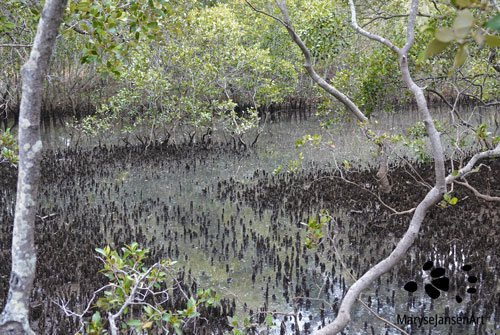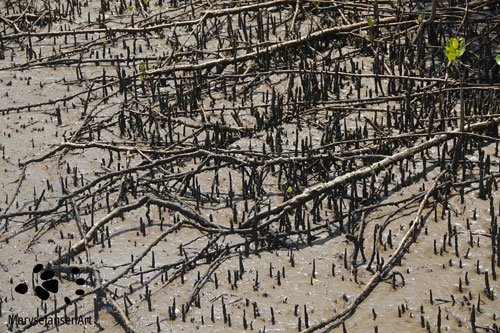Nature Photography with marysejansenart
Step into the world of the tree that grows pencil roots

There is something special about a walk in a mangrove forest. It’s like there is a different atmosphere. As soon as I enter the walk, I feel like I’ve entered a another world! The Grey Mangroves dominate here. They are not very tall trees, they grow 3-10m high. They can get old though, they can live up to 100 years!
Their amazing and unique aerial root system is visible above the waterline and complemented with gnarled tree trunks and sprawling, twisting branches that get entangled with the neighbouring trees! Mosquitos are buzzing, cicadas are singing, I hear a variety of birds and there’s a slight breeze rustling through the leaves. Faintly I can hear the water of the river flowing in the background. I feel like I’m ready to go on a treasure hunt!

Table of Contents
Living on the edge of land and sea
Mangroves live on the edge of land and sea. It’s a difficult place to live because they have to deal with the forces of the tides going in and out as well as with high levels of salt in the water. Not many plants are up to the task and mangroves are in fact the only trees in the world that can survive under these circumstances!
The mangrove forest creates a bufferzone that helps keep the coastline in place. It protects the coastline from storms, absorbs the energy of wind and incoming waves and thus helps prevent erosion.
In the soil it can store amazing amounts of carbon, up to 5 times the amount of a terrestrial forest! This phenomenon is also know as Blue Carbon.
The Grey Mangrove (Avicennia marina) is Australia’s most abundant mangrove species. This tree is well adapted to colonise a wide range of coastal soil conditions that are difficult for other species to get a foothold on. Furthermore, it can tolerate low temperatures so its range expands a lot further south than that of other mangrove species. Finally, it is very well adapted to cope with the intertidal environment. Its root systems protect it from being washed away, and also it has effective strategies to deal with the salt water.
Read here about another mangrove species, the Orange Mangrove.
Grey Mangrove Roots
Mangroves have different types of roots, performing different functions for the tree: stability, uptake of nutrients and supplying oxygen.
The trees need to anchor. They develop a heart root system, where several main roots grow vertically into the ground. This is to protect them from being washed away by the tides. At the same time, because Grey Mangroves grow on dense, muddy grounds or rocky, stony and sandy soils, it is not possible for them to grow deep roots, so they develop what is called a flat root system. The main roots spread out over a large surface and grow lots of smaller anchoring roots to keep the tree in place.
You may be familiar with the amazing stilt roots system that mangroves can grow. These are not typical for Grey Mangroves, but it is possible for them to grow these when their anchoring system is not strong enough to keep them in place.
Very specific for Grey Mangroves however is the pencil roots system (also sometimes called snorkels or peg roots). These aerial roots grow vertically up from the underground system and emerge above the ground. These roots can appear in a radius of up to 10m around the tree trunk! Their function is to collect oxygen for the tree, because the dense mud is very poor of oxygen. These small upright roots are essential for the survival of the tree!

The mangrove boardwalk that I’m walking on protects these little pencil roots from being trod on by people. But whenever I happen to walk somewhere where there is no boardwalk, I make sure to avoid stepping on these important lifelines!
The roots also provide amazing scenery and are a great source of natural abstract photography as shown in the featured image! I enjoy spending some time photographing them!
Mangroves offer shelter and food for many animals
The tangled structure of roots and branches provides shelter for many animals. Mangrove systems are important nurseries for many fish species. Most predators can’t reach them in here, so they have a relatively safe space to grow to a big enough size and ready to go out in the open ocean. As I enter the walk, the tide is high and just starting to go out. I see some fish in the shallow waters, navigating the maze of pencil roots.
As the water retreats, the crabs start to come out of their burrows in the mud. Numerous species of crabs live in this environment and they do a very important job for the mangrove ecosystem. They feed on detritus and mangrove leaf litter, thus bringing nutrients back into the system. Their burrowing habit creates pockets of oxygen in the mud which helps the vegetation. The crab larvae are a food source for the juvenile fish that live here. There are so many crabs around, of various species, it is fun to watch them. When they see me they are quick to retreat to their burrows so I have to be aware of my presence and try not to scare them.
A lot of bird species also like to call the mangroves home. These birds feed on the juvenile fish and small crustaceans that they can find here. Wading birds such as Egrets, Herons and Ibises love it here. I see them picking their steps between the roots, their feet in the shallow water, regularly catching small prey. A Mangrove Kingfisher tries its luck catching some fish from the river. There are also little songbirds chirping in the trees. They might be feeding on the mosquitos and other insects.
I don’t see them today, but this is also a good place for reptiles such as lizards, skinks and snakes. There’s plenty of food for them around and when the water rises they can easily climb the trees! In more northern areas of Australia, you will also find crocodiles in the mangroves!
How do mangroves cope with salt water?
Grey Mangroves can tolerate extremely high levels of salt! To be able to do that they have to use a combination of strategies:
- They resist uptake of salt at the roots by filtering it out. Grey Mangroves do this, but not as well as some other mangrove species. So, it is not enough!
- The main strategy of this species is the secretion of salt through salt glands on the leaves. You could taste it if you would lick the leaves. Alternatively, take a close look and notice the salt crystals that form on the Grey Mangrove leaves. Wind or rain removes these crystals from the surface.
- Any excess salt that concentrates in the leaves gets removed when the leaves fall.
- To help the whole process, the Grey Mangrove also has strategies to conserve water. The leaves are designed so that evaporation is minimalised. The pores are sunken below the leaf surface which protects them from drying winds. These trees can also turn their leaves to minimalise the surface that is exposed to the sun. The leaves are succulent which makes them able to store water in their tissue.
How do Grey Mangroves reproduce?
Grey Mangroves have an interesting reproductive system. Their flowers grow in clusters of 3-5 and are white to yellow. They are tiny, only 1cm wide. The tree produces large, green, oval-shaped, flattened seeds. Live seedlings are contained within these seeds when they drop from the tree. The seeds float on the water, searching for the ideal habitat. This can take a couple of days. It registers salt-levels and temperature to decide the best moment to drop the seed coat so that the seedling can attach itself to the ground and begin to grow!
I think Grey Mangroves are absolutely fascinating! Would you like to experience more of the wondrous world of a mangrove forest? Enjoy the latest episode of ‘Come for a walk in the Australian Bush’ and have a peek at the amazing wildlife!
If you are interested in purchasing ‘Grey Mangrove Roots Natural Abstract’ or would like to see what the image looks like on the various products, please head to my shop. If you prefer ‘Grey Mangrove Flat Roots and Pencil Roots’, click shop here.


